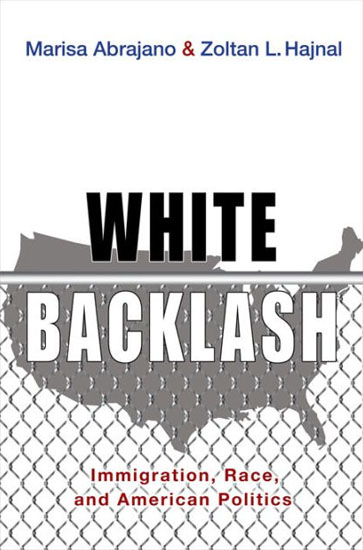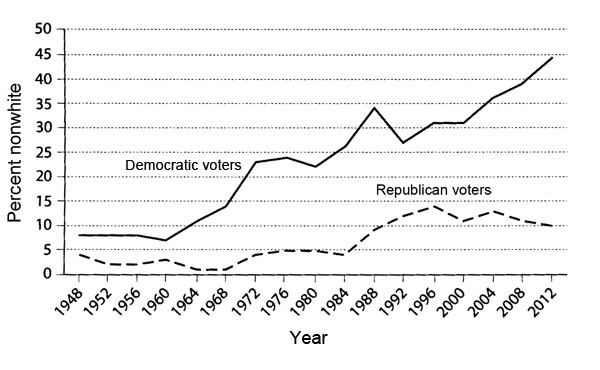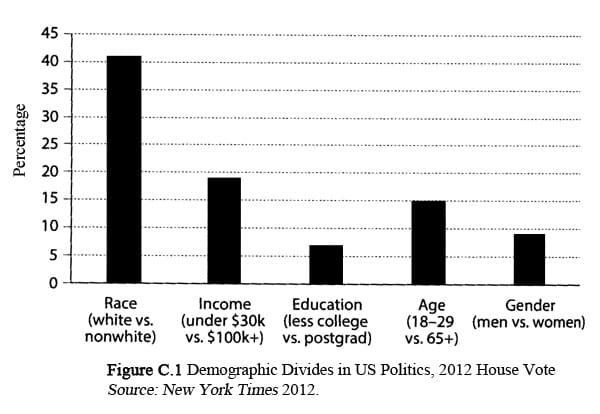Taming the White Beast
Jared Taylor, American Renaissance, March 11, 2016
Marisa Abrajano and Zoltan L. Hajnal, White Backlash: Immigration, Race, and American Politics, Princeton University Press, 2015, 241 pp., $29.95.
White Backlash is actually two books. The first is a reasonably rigorous attempt to determine whether the presence of large numbers of immigrants changes the politics and policy preferences of whites. It concludes that, indeed, in states with many Hispanics, whites are more likely to vote Republican and to want to curb government benefits for immigrants, especially illegal immigrants.

The other book is an expression of profound contempt for whites. The authors concede that “US society has been transformed in innumerable, deep, and perhaps permanent ways” through immigration, that there has been “a massive transformation in the makeup of the nation,” and that immigration brings “enormous social, economic, and cultural transformation.” But any resistance is pathological: “Views [of whites] on immigration have been linked to ethnocentrism, social dominance and authoritarian personality, nationalism and racial prejudice.”
The authors explain that any resistance to dispossession comes from the perception of “racial threat.” The arrival of non-whites provokes “unease,” “anxiety,” and “fear,” which lead to polices that are “regressive” and “punitive.” The authors also worry that “just when the United States is becoming more racially diverse, it is becoming more racially divided.” The best solution would be for whites to overcome their fear of displacement and all become liberals, but even if they do not, the coming non-white majority will legislate “progressive” policies that will save the nation.
White backlash
Needless to say, the title of this book is a sensational exaggeration. Whites–not just in the United States but around the world–have been uniquely supine in turning their nations over to aliens. The few spasms of sanity that the authors call a “backlash” have occurred at the state level because Congress has been unwilling to control the borders or pass immigration legislation. As the authors note, states have introduced nearly 7,000 immigration-related bills in the last decade or so, with 1,607 such measures in 2011 alone.
Not surprisingly, it is the states with the largest number of immigrants that introduce and pass the most immigration-related laws. Vermont, which by latest count, had only 5,284 Hispanics, has passed only one such law in the last five years. It was a resolution urging Congress to issue more visas for agricultural workers.
The authors introduce a great deal of data that show that the larger the number of Hispanics in a state, the more likely whites are to: Cut back on education, welfare, and health spending; build more prisons; support the death penalty; vote Republican; call themselves “conservative;” call for border control, immigration restriction, and deportation; and support “regressive” sales taxes rather “progressive” property taxes. As the authors put it, they have discovered “a shift in heavily Latino states toward policies that target and often punish the disadvantaged segments of the population.” This has “distressing implications” for immigrants.
The authors write as if they have discovered something new, but these tendencies got a name long ago: the Florida syndrome. For years, Florida voters, who are largely white, have cut back on school funding for a student population that is largely Hispanic.
The obvious, which does not seem to have occurred to the authors of White Backlash, is that people are more willing to pay taxes for social services that benefit people like themselves. White Floridians would not mind paying for good schools if their own children and grandchildren attended them–or if at least most of the students were white. Floridians don’t want to pay high taxes to educate the children of non-white immigrants, many of them illegal.
The same goes for every other element of “white backlash” the authors deplore. Sales taxes spread the tax burden to everyone–even to illegals who don’t pay income tax–whereas property taxes fall on property owners, who more likely to be white. Whites likewise resent paying for welfare benefits for foreigners.
Interestingly, the authors find that all whites tend to reduce their support for government measures to reduce income inequality as their state fills up with Hispanics, but the effect is three times stronger on “less well educated” than “well educated” whites. This could be seen as the opposite of what we might expect, since less well educated whites probably have low incomes and might benefit from handouts. On the other hand, they have probably not been exposed to as much “anti-racist” propaganda, and are freer to express anger over people they think of as foreign chiselers.
The authors also found that the presence of large numbers of Asian immigrants pushes whites in the opposite direction–Asians have “a liberalizing effect on white politics”–though it is not as strong as the “regressive” effect of Hispanics. The authors do not seem to realize that these findings undercut their “racial threat” analysis. Asians are just as non-white as Hispanics, but don’t cause whites to cut back on health and welfare spending or support the death penalty. Why not? “Whites tend to have different stereotypes of Asian Americans than they do of Latinos.” The authors cannot bring themselves to admit that whites are not reacting to race, but to behavior. Asians, who pull their own weight, do not provoke the same reaction as Hispanics, who join gangs and go on welfare.
The wicked New York Times
Why do whites who are exposed to the wonders of immigration pass “punitive” laws against it? The authors think they have found their answer in the press. They claim to have read every one of the 6,778 articles the New York Times wrote about immigration from 1980 to 2011. Of these, they claim only 12 percent had a positive tone, 49 percent were negative, and 39 percent were neutral.
The authors argue that if the liberal Times is slanted, we can well imagine the anti-immigrant bias that pervades the rest of the press: “By concentrating on immigration and highlighting its negative aspects, the media not only generate fears and concerns but also increase the motivation for many Americans to side with the Republican Party.” The authors are serious about the idea that the press turns whites into Republicans: “The skewed coverage makes it difficult for the majority of Americans to consider the full spectrum of immigrants’ contributions to society . . . . [and] could well shift the white public toward the Republican Party.” Certain words, moreover, have totemic power: “Even brief uses of terms such as illegal alien, illegal, and illegal immigrant could ignite readily available criminal scenarios that in turn increase opposition to immigration.”
The authors refuse to believe that negative stories about immigration simply reflect the negative reality of immigration, because they’re convinced immigration is objectively good for America. They conclude that the press promotes the “immigrant threat narrative” only because of “the profit-base incentives of the news media” drives them to publish hot-selling horror stories.
Racial politics
The authors conclude that just as black activism drove whites out of the Democratic Party from the 1960s to the 1980s, immigration does the same thing today. They include the graph below, which shows that during the 1950s, both parties got at least 90 percent of their votes from whites in national elections. Now, nearly half of the voters for Democratic candidates are non-white, while the figure for Republicans has settled back down to about 10 percent. In the 1950s, almost half of all whites considered themselves Democrats; now, only 25 percent do.

The table below is another way of depicting the racial divide. The bars show the difference in the likelihood of various groups to vote Republican during the congressional elections of 2012. Fifty-nine percent of whites voted for Republican candidates while only 18 percent of non-whites did. The difference between those figures is huge: 41 percent. No other political divide comes close, not even the partisan difference between people who make over $100,000 as opposed to those who make less than $30,000. As the authors note: “The racial divide dwarfs divisions across class and other demographic characteristics that are supposedly central to the political arena.” This is true for elections without party labels: “Race outweighs all other demographic divides in nonpartisan local elections as well.”

The authors don’t like the idea of American politics becoming a racial headcount, but what is the alternative? Whites must overcome their irrational conservatism–based as it is on “deep, enduring attitudes like ethnocentrism and prejudice”–and vote Democratic.
But what has divided American politics along racial lines? Immigration. When the country was overwhelmingly white, people voted by conviction, not race. Furthermore, it is non-whites–not whites–who vote along starkly racial lines. If 59 percent of whites voted Republican in the 2012 congressional elections it means 41 percent or so voted Democrat. But if only 18 percent of non-whites voted Republican it means more than 80 percent voted Democrat. The authors also note that 90 percent of elected Hispanics are Democrats. So which group lets race dictate its choices? One marvels at the blindness and arrogance with which the authors explain that the solution is for whites to vote Democrat.
But what else should we expect? As the authors explain, Democrats are “compassionate” while Republicans push “punitive and regressive policies.” This is why “the Republican Party along with its policies of exclusion, punishment, and retrenchment [on social services] should be an attractive option for these uneasy Americans [who think there is too much immigration].” Clearly, the United States has a party that stands for good and a party that stands for evil.
The goodness of Democrats justifies whatever it takes to increase their share of the vote. The authors even describe the abolition of national-origins quotas as a clever Democrat strategy. “In an effort to bring in more constituents who would ultimately support the party, Democrats undertook a sharp reversal of position and supported the Hart-Celler Act of 1965.” This “would become a critically important base for the Democratic Party over the ensuing decades.”
The authors are confident that immigration will continue to push the country towards virtue: “Once the size of the Latino population passes a certain threshold, Latinos should be able to mobilize to influence policy outcomes, and policy should begin to shift back to the left.” We are now witnessing whitey’s last gasp: “Thus, we believe that the pattern of immigration backlash should only hold until the Latino population becomes large enough to mobilize to effect policy change on its own.” This will usher in the millennium:
If the population projections of the US Census hold, so that whites lose their majority status in a few decades, then this emerging pattern bodes well for Latinos over the long term. Latinos’ influence should only grow more pronounced and policy should become more aligned with Latino preferences. . . . [T]his potentially represents a major step forward.
So there you have it: The more the country reflects the desires of Mexicans and Guatemalans the better it will be. Whites, who built the country that Mexicans and Guatemalans are destined to dominate, will have to stew in their own “ethnocentrism, social dominance and authoritarian personality, nationalism and racial prejudice” until Hispanics fix the country for them.
Author Marisa Abrajano, whose origins we can only imagine from her name and appearance, teaches political science at UC San Diego. Zoltan Hajnal also teaches at UC San Diego. Zoltan is a Hungarian name, so it’s unlikely his ancestors came over on the Mayflower. White Backlash is published by Princeton University Press.

Marisa Abrajano and Zoltan Hajnal
This is the perfect symbol for our degenerate times. Foreigners tell the American founding stock how benighted and deserving of oblivion we are, and are published by one of the country’s most prestigious academic presses. We have work to do.















